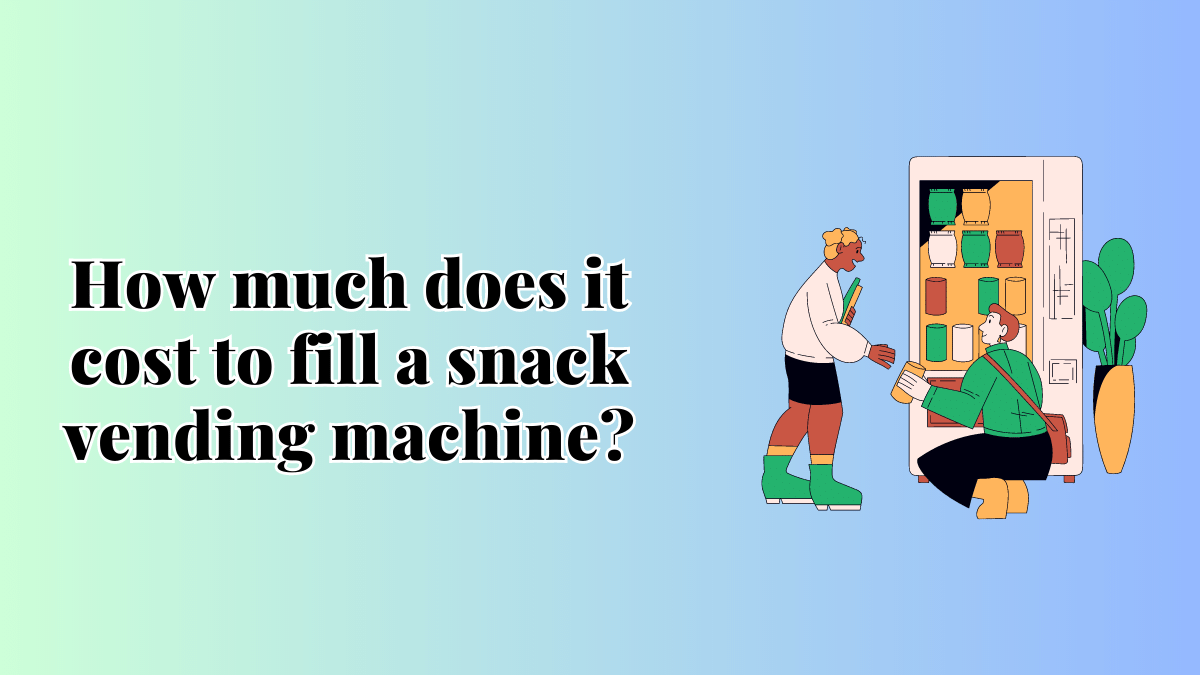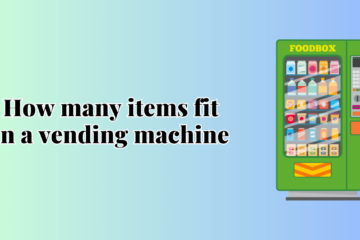When venturing into the vending machine business, one of the most crucial aspects to consider is the cost to fill a snack vending machine. Properly understanding these costs and optimizing your spending can greatly impact your profits and success. In this article, we’ll delve into the various factors that influence the expenses of filling a snack vending machine and provide valuable insights from an expert’s perspective.
Cost to Fill a Snack Vending Machine?
To Fill a snack vending machine involves several expenses, and it’s essential to be aware of these costs to ensure a profitable vending business. Here, we’ll explore the different aspects affecting the overall cost:
1. Inventory Costs
The primary cost to fill a snack vending machine lies in acquiring the inventory. The cost of snacks will vary based on factors like brand, size, and type. To minimize expenses, consider purchasing wholesale or in bulk to avail discounts.
2. Machine Location
The location of your vending machine plays a significant role in determining costs. High-traffic areas or prime spots typically come with higher rental fees or commissions. However, these locations can also lead to higher sales, ultimately impacting the cost-to-profit ratio.
3. Vending Machine Maintenance
Regular maintenance and servicing are essential to keep your vending machine running smoothly. This includes restocking, cleaning, and addressing any technical issues. While this adds to the costs, it ensures a well-functioning machine that attracts customers.
4. Energy Consumption
Snack vending machines require electricity to operate. Depending on your machine’s energy efficiency and the cost of electricity in your area, the monthly energy consumption costs can vary. Opt for energy-efficient machines to save on this aspect.
5. Payment Processing Fees
If your snack vending machine accepts cashless payments, there will be associated processing fees for credit or debit card transactions. Factor in these charges when calculating the overall cost of running your vending machine.
6. Transportation and Logistics
Getting your inventory to the vending machine location involves transportation costs. If you have multiple machines in different locations, optimizing the logistics can help reduce expenses.
7. Marketing and Promotion
Promoting your snack vending machine and attracting potential customers may require marketing efforts. Consider investing in eye-catching decals or promotional materials to increase visibility and sales.
8. Seasonal and Regional Variations
The cost of filling a snack vending machine can vary seasonally and regionally. Prices of certain snacks may fluctuate, especially during holidays or due to local supply and demand factors.
9. Security Measures
Implementing security measures to protect your vending machine and its inventory is crucial. Investing in sturdy locks and surveillance systems may incur additional costs but can safeguard your business in the long run.
10. Product Rotations and Expirations
Regularly rotating products and ensuring none of them reach their expiration date is essential. Removing expired items and replacing them can impact costs and avoid customer dissatisfaction.
11. Cash Handling and Collection
If your vending machine accepts cash, you’ll need to handle and collect money regularly. Account for the time spent on cash collection and any security measures related to cash handling.
12. Insurance
Insuring your vending machine against potential damages, theft, or accidents is a prudent decision. While it may add to your expenses, it provides peace of mind and protection for your investment.
13. Staffing Costs
If you choose to employ someone for restocking and maintaining the vending machine, staffing costs will be part of your overall expenditure.
14. Commission or Rent to the Location Owner
In some cases, vending machine owners pay a commission or rent to the location owner for allowing them to place the machine on their premises.
15. Diversifying Your Product Offering
Providing a wide range of snack options may attract more customers, but it can also increase inventory costs. Balancing variety and cost is crucial.
16. Monitoring and Analytics
Investing in monitoring tools and analytics software can help track sales and inventory levels, aiding in better decision-making and cost optimization.
17. Seasonal Promotions and Special Offers
Introducing seasonal promotions or special offers can drive sales but may involve discounted prices, impacting your profit margin.
18. Regular Market Research
Conducting regular market research can help you stay updated with customer preferences, allowing you to stock the most popular snacks and optimize your inventory costs.
19. Waste Management and Sustainability
Implementing eco-friendly practices and waste management strategies can contribute to overall cost savings and demonstrate your commitment to sustainability.
20. Negotiating with Suppliers
Negotiating with snack suppliers and other vendors can lead to better deals and cost savings in the long run.
21. Tax Considerations
Understanding tax implications and deductions related to your vending business can affect your overall costs.
22. Inventory Turnover
Ensuring a healthy inventory turnover rate can prevent spoilage and maximize profits.
23. Offering Healthy Snack Options
Incorporating healthy snack choices can cater to a broader customer base and align with evolving consumer preferences.
24. Expanding Your Vending Business
If you plan to expand your vending business, you’ll need to account for additional costs related to more machines and locations.
25. Optimizing Profitability
Regularly reviewing your expenses, analyzing sales data, and refining your strategies can optimize your vending business’s profitability.
FAQs
FAQ 1: Are there any cost-effective snack options available?
Answer: Yes, there are cost-effective snack options available, especially when purchased in bulk or directly from wholesalers. Look for deals and discounts to save on inventory costs.
FAQ 2: Can I negotiate with location owners for rent or commissions?
Answer: In some cases, location owners may be open to negotiations. It’s worth discussing the terms to find a mutually beneficial arrangement.
FAQ 3: How can I reduce energy consumption?
Answer: Opt for energy-efficient vending machines and consider setting timers for the machine to conserve electricity during off-peak hours.
FAQ 4: What are some effective marketing strategies for snack vending machines?
Answer: Utilize eye-catching decals, offer promotions, and use social media platforms to reach potential customers.
FAQ 5: Is it essential to offer healthy snack options?
Answer: While not mandatory, providing healthy snack choices can attract health-conscious customers and contribute to a positive brand image.
FAQ 6: How often should I rotate the products?
Answer: Aim to rotate products at least once a week to maintain freshness and avoid items reaching their expiration dates.
Conclusion
Running a successful snack vending machine business involves understanding the various costs associated with filling and maintaining the machines. By optimizing your expenses, negotiating with suppliers, and staying attentive to customer preferences, you can build a thriving vending business with healthy profit margins. Remember to stay adaptable and open to innovations to stay ahead in the competitive vending industry.




